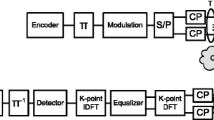Abstract
This paper presents novel very large scale of integration implementation of symbol detection based on modified householder transformation QR decomposition algorithm for 4th generation long term evolution downlink receiver. QR decomposition of a channel matrix H is decomposition of matrix H into an orthogonal matrix Q and an upper triangular matrix R. Pre-processing modules based on QRD makes the symbol detection in signal processing easier. Implementing symbol detection with QRD in multiple input multiple output-orthogonal frequency division multiplexing based LTE downlink receiver helps to reduce the complexity of that receiver. Because of simplicity and numerical stability, the householder QRD algorithm is considered and modified to reduce the computation time and hardware area of the QRD block compared to the existing householder algorithm. In order to show the efficiency, the existing and proposed modified householder transformation algorithms are designed, simulated using Xilinx ISE 14.1 and synthesized in FPGA Virtex6 xc6vlx550tl-1Lff1759 device.






Similar content being viewed by others
References
Im, T. H., Park, I., Kim, J., Yi, J., Kim, J., Yu, S., et al. (2009). A new signal detection method for spatially multiplexed MIMO systems and its VLSI implementation. IEEE Transactions on Circuits Systems II, 56, 399–403.
Tang, C. F. T., Liu, K. J. R., & Tretter, S. A. (1991), On systolic arrays for recursive complex householder transformations with applications to array processing. In International conference on acoustics, speech, and signal processing (pp. 1033–1036).
Hsiao, S. F., & Delosme, J. M. (1995). Householder CORDIC algorithms. IEEE Transactions Computers, 44, 990–1001.
Chung, K. L., & Yan, W. M. (1997). The complex householder transform. IEEE Transactions on Signal Processing, 45, 2374–2376.
Salmela, P., Burian, A., Sorokin, H., & Takala, J. (2008). Complex-valued QR decomposition implementation for MIMO receivers. In Proceeding on international conference on acoustics, speech, and signal processing (pp. 143–146).
Luethi, P., Studer, C., Duetsch, S., Zgraggen, E., Kaeslin, H., Felber, N., & Fichtner, K. (2008). Gram–Schmidt-based QR decomposition for MIMO detection: VLSI implementation and comparison. In Proceedings on IEEE Asia Pacific conference on circuits and systems (pp. 830–833).
Chang, R. C. H., Lin, C. H., Lin, K. H., Huang, C. L., & Chen, F. C. (2010). Iterative decomposition architecture using the modified Gram–Schmidt algorithm for MIMO systems. IEEE Transactions on Circuits Systems I: Regular Papers, 57, 1095–1102.
Maltsev, A., Pestretsov, V., Maslennikov, R., & Khoryaev, A. (2006). Triangular systolic array with reduced latency for QR decomposition of complex matrices. In IEEE international symposium on circuits and systems, Kos, Greece (pp. 385–388).
Hwang, Y. T., & Chen, W. D. (2008). A low complexity complex QR factorization design for signal detection in MIMO OFDM systems. In Proceedings of international symposium on circuits and systems (ISCAS) (pp. 932–935).
Patel, D., Shabany, M., & Gulak, P. G. (2009). A low-complexity high-speed QR decomposition implementation for MIMO receivers. In Proceedings of IEEE international symposium circuits and systems (ISCAS) (pp. 1409–1412).
Liu, L., Wang, J., Yan, D., & Liu, F. (2012). Sorted QR decomposition based tree search detection algorithm for MIMO systems. In 8th IEEE international conference on wireless communications, networking and mobile computing (WiCOM) (pp. 1–4).
Huang, Z.-Y., & Tsai, P.-Y. (2010). Efficient implementation of QR decomposition for gigabit MIMO–OFDM systems. In Proceeding of IEEE international symposium on circuits and systems (ISCAS) (pp. 1492–1495).
Kalyani, K., Siva, S., Sellathambi, D., & Rajaram, S. (2013). Parallel Distributed arithmetic based K-best List sphere detection algorithm for LTE standard. Procedia Engineering, 64, 133–141. (Elsevier).
Kalyani, K., Sellathambi, D., & Rajaram, S. (2013). Efficient QR Decomposition algorithm for LTE standard. In Proceedings of the fourth IEEE international conference on computing, communication and networking technologies (ICCCNT’13). (IEEE Explore).
Kalyani, K., Saipratap, S. N. V., & Rajaram, S. (2015). A novel QR factorization approach to multi-robot localization and mapping. International Journal of Applied Engineering Research, 10(2), 1356–1360.
Author information
Authors and Affiliations
Corresponding author
Rights and permissions
About this article
Cite this article
K, K., S, R. Hardware Implementation of Novel Symbol Detection Algorithm for 4G LTE Downlink Receiver. Wireless Pers Commun 96, 977–988 (2017). https://doi.org/10.1007/s11277-017-4214-3
Published:
Issue Date:
DOI: https://doi.org/10.1007/s11277-017-4214-3




